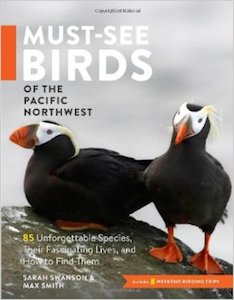Although perhaps not the first geographic location that springs to mind when the topic of U.S. birding hot spots arises, the northwest corner of the lower forty-eight states is truly an under-appreciated wonderland of bird species. Encompassing as it does a wide range of habitat types – from sage-covered high desert and alpine meadows to temperate rain forests and both rocky as well as sandy seashores – in a reasonably compact area, the Pacific Northwest is home to a number of birds found nowhere else in the country.
Not surprisingly, bird watchers local to the area are understandably proud of their area’s birdlife and are generally very enthusiastic to share it with others, a regional trait exceptionally well exemplified by Sarah Swanson and Max Smith in their new book Must-See Birds of the Pacific Northwest; 85 Unforgettable Species, Their Fascinating Lives, and How to Find Them.
Both being natural history professionals – Swanson is an environmental educator, Smith a wildlife biologist – as well as avid bird watchers, the authors draw deeply upon their extensive knowledge of the region and its birdlife to present the reader with a very inviting overview of some of Oregon and Washington’s most iconic, sought-after, and in many cases most beloved bird species. Indeed, to make their work as accessible to both newcomers either the region or the hobby of bird watching itself – perhaps even both – Swanson and Smith have eschewed as much scientific terminology and classification as would be thought reasonable to ensure that everyone interested in learning a bit more about and enjoying the area’s birdlife is given as great a chance as possible to do so without feeling intimidated by a lack of previous experience.
For example, by grouping their subject species into such common-sense categories as “Beach Birds,” “Urban Birds,” and “Tree Trunk Birds” rather than in their taxonomic arrangement, Swanson and Smith can avoid long – and quite frankly, for beginners, off-putting – explanations of taxonomy and focus on the birds themselves; and what birds they are! From Harlequin Ducks and Heermann’s Gulls to Calliope Hummingbirds and Lazuli Buntings, each species is presented with a brief conversational summary of key points to its life history – primarily what they eat, how they raise their young, and their migratory habits – followed by the all-important “Where To Find” them information. However rather than directing readers to each species by habitat descriptors, for more useful suggestions for specific named locations (refuges, parks, harbors, etc.) to see each species is given. Almost needless to note in such a well thought-out book, the photos accompanying each species account are superb and well worth the cover price all on their own.
Finally, for those interested in making a week-end out of some of Swanson and Smith’s suggestions, eight geographically varied easy-to-follow overnight trip outlines are provided. Whether one would like to discover the wintering birds of the Salish Sea or watch the courtship displays of breeding birds in the Klamath Basin, these trips suggestions are remarkably useful not only for both beginning and experienced bird watchers alike.
Must-See Birds of the Pacific Northwest is a delightful work by two exceptionally talented natural history writers that will not fail to enlighten the reader – regardless of his or her previous experience with the region – about the fascinating birdlife to be found in one of the nation’s, or for that matter the world’s, most beautiful and naturally diverse areas. It is whole-heartedly recommended to all.
 Title: Must-See Birds of the Pacific Northwest
Title: Must-See Birds of the Pacific Northwest
Authors: Sarah Swanson and Max Smith
Publisher: Timber Press
Imprint: Timber Press
Format: Paperback
ISBN: 9781604693379
Pages: 244
Date of Publication: 2013
This review was originally published in the November / December 2013 issue of Bird Watcher’s Digest.
In accordance with Federal Trade Commission 16 CFR Part 255, it is disclosed that the copy of the book read in order to produce this review was provided gratis to the reviewer by the publisher.

Review Roundup: July, 2014
August 6, 2014 @ 16:53
[…] The Well-read Naturalist […]